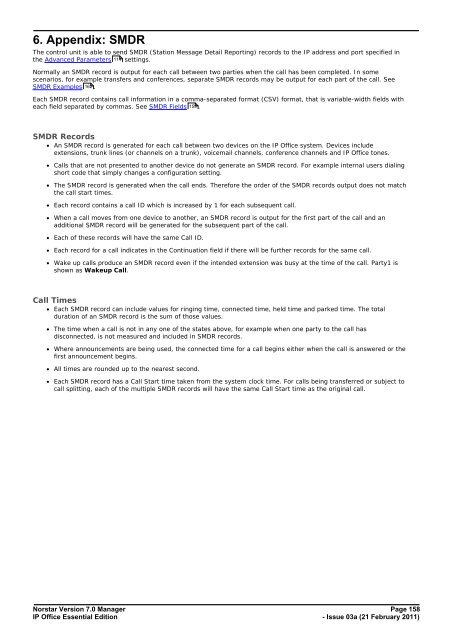Norstar Version - IP Office Info
Norstar Version - IP Office Info
Norstar Version - IP Office Info
Create successful ePaper yourself
Turn your PDF publications into a flip-book with our unique Google optimized e-Paper software.
6. Appendix: SMDR<br />
The control unit is able to send SMDR (Station Message Detail Reporting) records to the <strong>IP</strong> address and port specified in<br />
the Advanced Parameters 114 settings.<br />
Normally an SMDR record is output for each call between two parties when the call has been completed. In some<br />
scenarios, for example transfers and conferences, separate SMDR records may be output for each part of the call. See<br />
SMDR Examples 162 .<br />
Each SMDR record contains call information in a comma-separated format (CSV) format, that is variable-width fields with<br />
each field separated by commas. See SMDR Fields 159 .<br />
SMDR Records<br />
· An SMDR record is generated for each call between two devices on the <strong>IP</strong> <strong>Office</strong> system. Devices include<br />
extensions, trunk lines (or channels on a trunk), voicemail channels, conference channels and <strong>IP</strong> <strong>Office</strong> tones.<br />
· Calls that are not presented to another device do not generate an SMDR record. For example internal users dialing<br />
short code that simply changes a configuration setting.<br />
· The SMDR record is generated when the call ends. Therefore the order of the SMDR records output does not match<br />
the call start times.<br />
· Each record contains a call ID which is increased by 1 for each subsequent call.<br />
· When a call moves from one device to another, an SMDR record is output for the first part of the call and an<br />
additional SMDR record will be generated for the subsequent part of the call.<br />
· Each of these records will have the same Call ID.<br />
· Each record for a call indicates in the Continuation field if there will be further records for the same call.<br />
· Wake up calls produce an SMDR record even if the intended extension was busy at the time of the call. Party1 is<br />
shown as Wakeup Call.<br />
Call Times<br />
· Each SMDR record can include values for ringing time, connected time, held time and parked time. The total<br />
duration of an SMDR record is the sum of those values.<br />
· The time when a call is not in any one of the states above, for example when one party to the call has<br />
disconnected, is not measured and included in SMDR records.<br />
· Where announcements are being used, the connected time for a call begins either when the call is answered or the<br />
first announcement begins.<br />
· All times are rounded up to the nearest second.<br />
· Each SMDR record has a Call Start time taken from the system clock time. For calls being transferred or subject to<br />
call splitting, each of the multiple SMDR records will have the same Call Start time as the original call.<br />
<strong>Norstar</strong> <strong>Version</strong> 7.0 Manager Page 158<br />
<strong>IP</strong> <strong>Office</strong> Essential Edition<br />
- Issue 03a (21 February 2011)

















